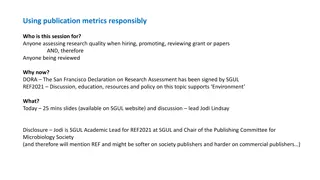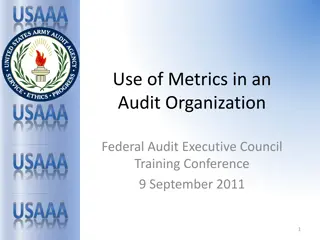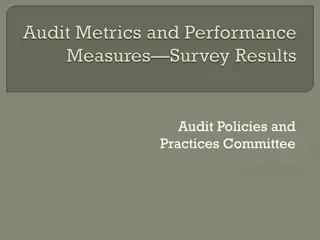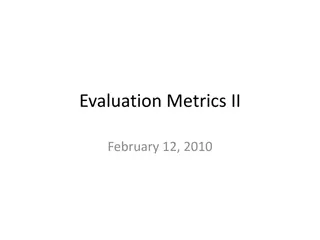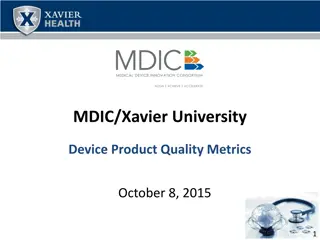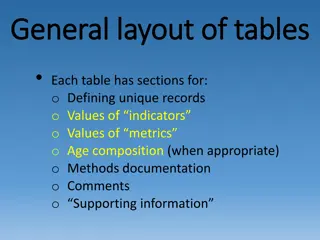Understanding Evaluation Metrics in Machine Learning
Evaluation metrics play a crucial role in assessing the performance of machine learning models. They help quantify how well a model is achieving a specific business objective, guiding efforts to improve performance, and track progress over time. Through metrics like accuracy, precision, recall, and more, teams can effectively analyze model outcomes and address issues like bias and variance. This overview delves into why metrics are essential, focusing on binary classification models and the significance of score-based evaluations.
Download Presentation

Please find below an Image/Link to download the presentation.
The content on the website is provided AS IS for your information and personal use only. It may not be sold, licensed, or shared on other websites without obtaining consent from the author. Download presentation by click this link. If you encounter any issues during the download, it is possible that the publisher has removed the file from their server.
E N D
Presentation Transcript
Evaluation Metrics CS229 Anand Avati
Topics Why? Binary classifiers Rank view, Thresholding Metrics Confusion Matrix Point metrics: Accuracy, Precision, Recall / Sensitivity, Specificity, F-score Summary metrics: AU-ROC, AU-PRC, Log-loss. Choosing Metrics Class Imbalance Failure scenarios for each metric Multi-class
Why are metrics important? - - Training objective (cost function) is only a proxy for real world objective. Metrics help capture a business goal into a quantitative target (not all errors are equal). Helps organize ML team effort towards that target. - Generally in the form of improving that metric on the dev set. Useful to quantify the gap between: - Desired performance and baseline (estimate effort initially). - Desired performance and current performance. - Measure progress over time (No Free Lunch Theorem). Useful for lower level tasks and debugging (like diagnosing bias vs variance). Ideally training objective should be the metric, but not always possible. Still, metrics are useful and important for evaluation. - - - -
Binary Classification X is Input Y is binary Output (0/1) Model is = h(X) Two types of models Models that output a categorical class directly (K Nearest neighbor, Decision tree) Models that output a real valued score (SVM, Logistic Regression) Score could be margin (SVM), probability (LR, NN) Need to pick a threshold We focus on this type (the other type can be interpreted as an instance)
Score based models Score = 1 Positive labelled example Negative labelled example #positives Prevalence = #positives + #negatives Score = 0
Score based models : Classifier Label positive Label negative Th Predict Negative Predict Positive 0.5 Th=0.5
Point metrics: Confusion Matrix Label Positive Label Negative Th 9 2 Predict Negative Predict Positive 0.5 Th=0.5 8 1
Point metrics: True Positives Label positive Label negative Th TP 2 9 Predict Negative Predict Positive 0.5 9 Th=0.5 8 1
Point metrics: True Negatives Label positive Label negative Th TP TN 9 2 Predict Negative Predict Positive 0.5 9 8 Th=0.5 8 1
Point metrics: False Positives Label positive Label negative Th TP TN FP 9 2 Predict Negative Predict Positive 0.5 9 8 2 Th=0.5 8 1
Point metrics: False Negatives Label positive Label negative Th TP TN FP FN 9 2 Predict Negative Predict Positive 0.5 9 8 2 1 Th=0.5 8 1
FP and FN also called Type-1 and Type-2 errors Could not find true source of image to cite
Point metrics: Accuracy Label positive Label negative Th TP TN FP FN Acc 2 9 Predict Negative Predict Positive 0.5 9 8 2 1 .85 Th=0.5 8 1
Point metrics: Precision Label positive Label negative Th TP TN FP FN Acc Pr 9 2 Predict Negative Predict Positive 0.5 9 8 2 1 .85 .81 Th=0.5 8 1
Point metrics: Positive Recall (Sensitivity) Label positive Label negative Th TP TN FP FN Acc Pr Recall 2 9 Predict Negative Predict Positive 0.5 9 8 2 1 .85 .81 .9 Th=0.5 8 1
Point metrics: Negative Recall (Specificity) Label positive Label negative Th TP TN FP FN Acc Pr Recall Spec 9 2 Predict Negative Predict Positive 0.5 9 8 2 1 .85 .81 .9 0.8 Th=0.5 8 1
Point metrics: F score Label positive Label negative Th TP TN FP FN Acc Pr Recall Spec F1 9 2 Predict Negative Predict Positive 0.5 9 8 2 1 .85 .81 .9 .8 .857 Th=0.5 8 1
Point metrics: Changing threshold Label positive Label negative Th TP TN FP FN Acc Pr Recall Spec F1 7 2 Predict Negative Predict Positive 0.6 7 8 2 3 .75 .77 .7 .8 .733 Th=0.6 8 3
Threshold TP TN FP FN Accuracy Precision Recall 0.50 0.55 0.60 0.55 0.60 0.65 0.70 0.65 0.70 0.75 0.80 0.85 0.80 0.75 0.70 0.65 0.60 0.55 0.50 0.55 0.50 Specificity F1 Threshold Scanning 1.00 0.95 0.90 0.85 0.80 0.75 0.70 0.65 0.60 0.55 0.50 0.45 0.40 0.35 0.30 0.25 0.20 0.15 0.10 0.05 0.00 0 1 2 2 3 4 5 5 6 7 8 9 9 9 9 9 9 9 9 10 10 10 9 9 9 9 8 8 8 8 8 7 6 5 4 3 2 1 1 0 0 0 0 1 1 1 1 2 2 2 2 2 3 4 5 6 7 8 9 9 10 9 8 8 7 6 5 5 4 3 2 1 1 1 1 1 1 1 1 0 0 1 1 1 0 1 1 1 0 0.1 0.2 0.2 0.3 0.4 0.5 0.5 0.6 0.7 0.8 0.9 0.9 0.9 0.9 0.9 0.9 0.9 0.9 0.182 0.333 0.308 0.429 0.533 0.625 0.588 0.667 0.737 0.800 0.857 0.818 0.783 0.750 0.720 0.692 0.667 0.643 0.690 0.667 0.667 0.750 0.800 0.833 0.714 0.750 0.778 0.800 0.818 0.750 0.692 0.643 0.600 0.562 0.529 0.500 0.526 0.500 0.9 0.9 0.9 0.9 0.8 0.8 0.8 0.8 0.8 0.7 0.6 0.5 0.4 0.3 0.2 0.1 0.1 Score = 1 Threshold = 1.00 Threshold = 0.00 Score = 0 10 10 1 1 10 0
How to summarize the trade-off? {Precision, Specificity} vs Recall/Sensitivity
Summary metrics: ROC (rotated version) Score = 1 Score = 0
Summary metrics: PRC Score = 1 Score = 0
Summary metrics: Log-Loss motivation Score = 1 Score = 1 Model B Model A Score = 0 Score = 0 Two models scoring the same data set. Is one of them better than the other?
Summary metrics: Log-Loss Score = 1 Score = 1 These two model outputs have same ranking, and therefore the same AU-ROC, AU-PRC, accuracy! Gain = Log loss rewards confident correct answers and heavily penalizes confident wrong answers. exp(E[log-loss]) is G.M. of gains, in [0,1]. One perfectly confident wrong prediction is fatal. Gaining popularity as an evaluation metric (Kaggle) Score = 0 Score = 0
Calibration Logistic (th=0.5): Precision: 0.872 Recall: 0.851 F1: 0.862 Brier: 0.099 SVC (th=0.5): Precision: 0.872 Recall: 0.852 F1: 0.862 Brier: 0.163 Brier = MSE(p, y)
Unsupervised Learning logP(x) is a measure of fit in Probabilistic models (GMM, Factor Analysis) High logP(x) on training set, but low logP(x) on test set is a measure of overfitting Raw value of logP(x) hard to interpret in isolation K-means is trickier (because of fixed covariance assumption)
Class Imbalance: Problems Symptom: Prevalence < 5% (no strict definition) Metrics: may not be meaningful. Learning: may not focus on minority class examples at all (majority class can overwhelm logistic regression, to a lesser extent SVM)
Class Imbalance: Metrics (pathological cases) Accuracy: Blindly predict majority class. Log-Loss: Majority class can dominate the loss. AUROC: Easy to keep AUC high by scoring most negatives very low. AUPRC: Somewhat more robust than AUROC. But other challenges. - What kind of interpolation? AUCNPR? In general: Accuracy << AUROC << AUPRC
Multi-class (few remarks) Confusion matrix will be NxN (still want heavy diagonals, light off-diagonals) Most metrics (except accuracy) generally analysed as multiple 1-vs-many. Multiclass variants of AUROC and AUPRC (micro vs macro averaging) Class imbalance is common (both in absolute, and relative sense) Cost sensitive learning techniques (also helps in Binary Imbalance) Assign $$ value for each block in the confusion matrix, and incorporate those into the loss function.
Choosing Metrics Some common patterns: - High precision is hard constraint, do best recall (e.g search engine results, grammar correction) -- intolerant to FP. Metric: Recall at Precision=XX% High recall is hard constraint, do best precision (e.g medical diag). Intolerant to FN. Metric: Precision at Recall=100% Capacity constrained (by K). Metric: Precision in top-K. Etc. - - - - Choose operating threshold based on above criteria.





